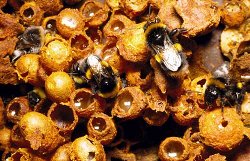Dublin Beekeeping Services
Honeybee & Swarm Removal Service
Bumble Bees

Bumblebee
Often confused with Honey Bees, the Bumble Bee is larger, furrier are generally black with varying degrees of yellow/red banding across the end of their tails. There are 20 different species of bumblebees in Ireland. 14 true bumble bees and 6 cuckoo bumble bees.
They are social insects, living in colonies of 50 to 500 workers, depending on the species. Queens hibernate during the winter, emerging in spring to find suitable nest sites - for example, abandoned mouse holes. Some species emerge as early as February. They can be seen from spring until late autumn. Each queen builds a nest of dried grasses and then lays about a dozen eggs that hatch into workers - sterile females.
The workers gather pollen and nectar to feed later batches of grubs. New queens and males hatch at the end of the season and mate. The males, workers and old queens die; new queens hibernate. Bumblebees are not aggressive and will only sting if they feel threatened. They are important pollinators of many plants and fruiting trees.

Bumblebee nest
What to do if you find a Nest
- Try not to disturb it. If it's in an awkward place try to put up with it for a few weeks. Remember it will die out with the first frosts and can then be safely removed.
- One tip - should the bees be nesting under a wooden building they often seem to exit on the most inconvenient space. Open another exit, perhaps on another side of the shed and leave it for a few days for the bees to find. Then block up the old exit. Removing a nest to a temporary cardboard hive, closing it at dusk for removal and relocation to a new site is sometimes possible. But you need an experienced bee-keeper with protective clothing and veil to do this delicate job.
The Life Cycle of the Bumble Bee
In the first warm days of spring you will see the large queens flying about the early flowers. These large slow bees are searching for nectar and pollen to turn into food for their newly hatching brood.

Buff tailed bumblebee
The queen will locate a suitable place to build her nest. Most common are the leaf litter in a compost heap, an old mouse hole, under the wooden floor of a garden shed.
The queen begins a nest into which she lays just a few (approx 6) eggs at a time. When the eggs hatch into worker bees they begin work to support the colony and their queen. The Queen continues to lay eggs, but as it takes more and more of her time the pollen and nectar collection is delegated to the workers, the queen spending her whole time in the nest.
Later in the summer the queen lays eggs destined to become next year's queen bees as well as drones or male bees. The drones only purpose being to mate with the young queens to ensure the survival of the species. Unlike honey bees the young bumble queens will continue to live and work in the mother colony for the remainder of the summer and autumn.
Come the first sharp drop in temperature and frosts the old queen, her workers and the drones will die. Only the newly mated queens will survive in hibernation to begin the cycle again the following spring.
Every autumn young mated queens seek out a place to hibernate in safety. Queens hibernate during the winter, emerging in spring to find suitable nest sites.

Red tailed bumblebee
- Because they live in small nests bumble bees never swarm - and you can encourage a nest or two in the garden without fear of this happening.
- Bumble bees do not produce enough honey for commercial use, just a few grams at a time to feed their young.
- Bumble bees are much less aggressive than honey bees.

Bumblebee nest

Bumblebee nesting box